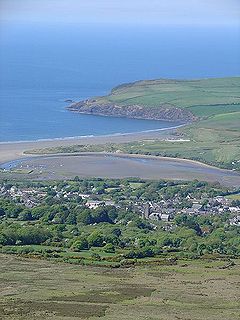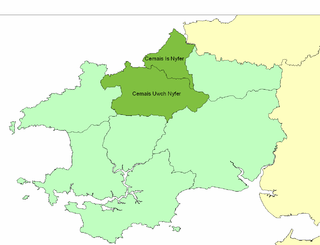History
Deheubarth
Although the area is not mentioned by it, an allegorical poem in the Black Book of Carmarthen [2] has been extrapolated by some writers to conclude that the area must have once been under the rule of Cuhelyn the Bard [ cy ], [3] a descendant of whom was later granted land in the nearby Preseli Hills by charter. [4] [5] In this period, Nevern served as the ecclesiastical centre of the area, and may have been the seat of a bishop. [6]
12th century
Following Henry I's death in 1135, anarchy followed due to conflict between rival claimants. Gruffydd took the opportunity to reconstruct Deheubarth. Raising an army, Gruffydd conquered much of former Deheubarth including Cemais by 1136. Robert fitz Martin was expelled from the lands. His son, William Fitz Martin, received Kemes as a dowry when he married Angharad, a daughter of Rhys ap Gruffydd. [14]
In 1189, King Henry II died, and Rhys went to Oxford to render homage to Henry's successor Richard the Lionheart; [15] he had been accompanied by Prince John (Richard's brother), but Richard actively refused to meet Rhys, [16] which made Rhys furious. [15] In 1191, despite an previous oath not to do so, Rhys seized Cemais from William Fitz-Martin, and gave it to his son, Gruffydd. [15]
Rhys, however, had an older, bastard, son, Maelgwn, who had become a bitter rival of his brother; Welsh inheritance law allowed bastards to inherit, but Rhys preferred the English practice, which did not, and had been grooming Gruffydd as his successor. Maelgwn attacked Cemais, and took it from Gruffydd, eventually imprisoning his own father—Rhys—in Nevern castle; a younger son, Hywel, eventually released him. [15] When war broke out upon Rhys's death in 1197, between Maelgwn and Gruffydd, William fitz Martin re-established his control of Kemes, founding a new caput at Newport; the eventual victor of the war—Maelgwn—did not displace him.
13th century
Kemes remained with William's descendants during the 13th century; even though it was captured by Llywelyn Fawr in 1215 and his grandson in 1257, on both occasions the Fitz-Martins successfully recovered it. [17] In 1326, two years after his similarly named father, the reigning Lord Martin (the Fitz having been dropped earlier in the previous century) died childless, and the Lordship was inherited by his sister, Joan, and her husband, James Audley. The Barons Audley arising from their marriage held the Lordship of Kemes until 1497, when the 7th Baron Audley rebelled against King Henry VII, failed, and was thus executed for high treason, with his lands declared forfeit.
16th century Pembrokeshire
In 1534, Henry VIII transferred the lands from the crown to John Tuchet, 8th Baron Audley, as an English feudal barony. Henry had already decided upon the course which would see the status of Marcher Lord entirely abolished the following year, by the first of the Laws in Wales Acts. This Act transformed the former Marcher Lordship of Kemes and the surrounding Marcher Lordship of Pembroke (together with Dewisland) into Pembrokeshire. Pembrokeshire was administratively subdivided into Hundreds, with Cemais largely falling into the new Hundred named Cemais, [18] except for the parish of Llantood (which became part of the neighbouring Cilgerran hundred). A small portion of the former Cantref of Gwarthaf was also included in the Hundred of Cemais.
John sold the feudal barony of Cemais two years later, to a local lawyer, William Owen. [19] He was succeeded in 1574 by his son, George Owen, whose antiquarian interests led him to produce a detailed parish-by-parish description of the Lordship in his second book [20] as well as a detailed description of the boundaries of the hundred. [12]

Rhys ap Gruffydd or ap Gruffudd was the ruler of the kingdom of Deheubarth in south Wales from 1155 to 1197. Today, he is commonly known as The Lord Rhys, in Welsh Yr Arglwydd Rhys, although this title may have not been used in his lifetime. He usually used the title "Proprietary Prince of Deheubarth" or "Prince of South Wales", but two documents have been discovered in which he uses the title "Prince of Wales" or "Prince of the Welsh". Rhys was one of the most successful and powerful Welsh princes, and, after the death of Owain Gwynedd of Gwynedd in 1170, the dominant power in Wales.

Newport is a town, parish, community, electoral ward and ancient port of Parrog, on the Pembrokeshire coast in West Wales at the mouth of the River Nevern in the Pembrokeshire Coast National Park.

Nevern is both a parish and a community in Pembrokeshire, Wales. The community includes the settlements of Felindre Farchog, Monington, Moylgrove and Bayvil. The small village lies in the Nevern valley near the Preseli Hills of the Pembrokeshire Coast National Park 2 miles (3 km) east of Newport on the B4582 road.
Maelgwn ap Rhys was prince of part of the kingdom of Deheubarth in south west Wales.
The Battle of Crug Mawr, sometimes referred to as the Battle of Cardigan, took place in September or October 1136, as part of a struggle between the Welsh and Normans for control of Ceredigion, West Wales.

Rhys Gryg, real name Rhys ap Rhys, also known as Rhys Fychan was a Welsh prince who ruled part of the Kingdom of Deheubarth.

Wiston Castle is a motte and bailey castle in the Pembrokeshire village of Wiston in south west Wales and is one of the best examples of its type in Wales. The castle and village were founded by Wizo, a Flemish settler who was granted the land by Henry I of England after he had wrested control from the previous owner, Arnulf de Montgomery. The castle was captured by the Welsh on several occasions but on each occasion it was retaken. It was abandoned during the thirteenth century when the then owner moved to nearby Picton Castle.

FitzMartin was the surname of a Norman family based in England and Wales between 1085 and 1342.
Robert fitz Martin was a Norman knight from Devon whose father, Martin de Turribus, was the first Norman Lord of Kemes, in what had previously been the Dyfed part of Deheubarth.
The Lords of Cemais were the ruling families, from the early 12th century of the Marcher Lordship of Kemes, and in later centuries of the barony of Cemais in Wales.

Llawhaden is a village, parish and community in the Hundred of Dungleddy, Pembrokeshire, West Wales. The community of Llawhaden includes the parish of Robeston Wathen, part of Narberth and the hamlet of Gelli, and had a population of 634 in 2001, increasing to 688 at the 2011 Census.
The River Nevern is a river in Pembrokeshire, Wales. Its source is north of the village of Crymych and its length is about 11 miles (18 km) to its estuary at Newport, Pembrokeshire.

The Hundred of Dewisland was a hundred in northwest Pembrokeshire, Wales. Formerly the pre-Norman cantref of Pebidiog, it included the city and the peninsula of St Davids. It was named after Dewi Sant, the Welsh name for Saint David.

Cemais Uwch Nyfer was a mediaeval Welsh commote in the Dyfed cantref of Cemais, in what is now Pembrokeshire. It consisted of the territory between the Afon Nyfer and Fishguard, and its civil headquarters were at Newport.

Emlyn was one of the seven cantrefi of Dyfed, an ancient district of Wales, which became part of Deheubarth in around 950. It consisted of the northern part of Dyfed bordering on the River Teifi. Its southern boundary followed the ridge of the line of hills separating the Teifi valley from the valleys of the Tâf and Tywi.
This article is about the particular significance of the century 1101–1200 to Wales and its people.

The history of Gwynedd in the High Middle Ages is a period in the History of Wales spanning the 11th through the 13th centuries. Gwynedd, located in the north of Wales, eventually became the most dominant of Welsh principalities during this period. Distinctive achievements in Gwynedd include further development of Medieval Welsh literature, particularly poets known as the Beirdd y Tywysogion associated with the court of Gwynedd; the reformation of bardic schools; and the continued development of Cyfraith Hywel. All three of these further contributed to the development of a Welsh national identity in the face of Anglo-Norman encroachment of Wales.

Newport Castle is a castle located in Newport, Pembrokeshire, Wales. The earliest castle on the site was built in the 13th century, and the present structure was built in the 19th century and is a private residence.

Cemaes Head is a headland and nature reserve in north Pembrokeshire. It lies in the community of St Dogmaels, within the Pembrokeshire Coast National Park. To the west and north it overlooks Cardigan Bay, and to the east Cardigan Island and the estuary of the River Teifi.














